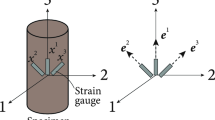Abstract
Various devices can directly or indirectly measure strain and record the deformational response of rock materials in uniaxial compressive strength tests. Strain gauges glued to specimens directly measure electrical resistance, while displacement sensors, typically linear variable differential transformers (LVDTs), indirectly measure linear displacements. However, no guidance is available regarding how to position the LVDTs to accurately measure axial or radial strain. A common practice is to measure axial strain with displacement sensors on the basis of the reduction in span between steel platens in relation to specimen height. If the deformational response for axial strain measured using strain gauges and displacement sensors is compared, however, it may be that neither maximum axial strain nor elastic constants are the same. This paper describes an approach to correcting platen-to-platen displacement measurements based on energy calculations at different scales in Olkiluoto gneissic rock specimens, with control specimens tested by combining strain gauge and displacement sensor measurements. It is suggested that the approach may be adaptable to other rocks.



















Similar content being viewed by others
References
Acar C, Gunduz Z, Kara B (2014) Modulus of elasticity determination of rocks using compressometer, strain gauge and LVDT. 11th International Congress on Advances in Civil Engineering- ACE 2014
Alejano LR, Arzùa J, Castro-Filgueira U, Kiuru R (2018) Scale effect of intact Olkiluoto gneissic rocks through uniaxial compressive testing and geophysical measurements. Posiva Work-report 2018-13. Posiva Oy, Helsinki http://www.posiva.fi/en/databank/workreports/. Accessed 15 Feb 2019
Arzúa J, Alejano LR (2013) Dilation in granite during servo-controlled triaxial strength tests. Int J Rock Mech Min Sci 61:43–56
Behrestaghi M, Sehizadeh M, Young R (2018) ONKALO POSE experiment - integrated analyses of true-triaxial tests. Posiva Oy Report, Helsinki (http://www.posiva.fi/en/databank)
Bieniawski ZT, Bernede MJ (1979) Suggested methods for determining the uniaxial compressive strength and deformability of rock materials. Int J Rock Mech Min Sci Geomech Abstr 16:138–140
Brady BHG, Brown ET (2004) Rock mechanics for underground mining, 3rd edn. Kluwer Academic Publisher, London 628 pp
Diederichs MS, Kaiser PK (1999) Stability of large excavations in laminated hard rock masses: the voussoir analogue revisited. Int J Rock Mech Min Sci 36:97–117
Eloranta P (2006) Laboratory testing of gneissic rocks in Olkiluoto borehole Ol-KR24. Posiva working report 2006-80. Posiva Oy, Helsinki
Fairhurst CE, Hudson JA (1999) Draft ISRM suggested method for the complete stress-strain curve for intact rock in uniaxial compression. Int J Rock Mech Min Sci Geomech Abstr 36:281–289
Fattahi H, Moradi A (2018) A new approach for estimation of the rock mass deformation modulus: a rock engineering systems-based model. Bull Eng Geol Environ 77:363–374
Fogged NN, Andreassen KA (2016) Strength and deformation properties of volcanic rocks in Iceland. Proceedings of the 17th Nordic Geotechnical Meeting: Challenges in Nordic Geotechnic 25th – 28th of May
Hakala M, Heikkilä E (1997) Laboratory testing of Olkiluoto mica gneiss in borehole OL -KR 1. Report POSIVA-97-04. Posiva Oy, Helsinki
ISRM (2007) Suggested methods for determining the uniaxial compressive strength and deformability of rock materials. In ‘The complete ISRM suggested methods for rock characterization, testing and monitoring: 1974–2006’. Prepared by the Commission on Testing Methods, ISRM. Ankara, Turkey: Ulusay R, Hudson JA eds.
Kim Y-S, Tatsuoka F, Ochi K (1994) Deformation characteristics at small strains of sedimentary soft rocks by triaxial compression tests. Geotech 44:461–478
Korinets A, Alehossein H (2002) On the initial non-linearity of compressive stress-strain curves for intact rock. Rock Mech Rock Eng 35:319–328
Małkowski P, Ostrowski Ł, Brodny J (2018) Analysis of Young’s modulus for Carboniferous sedimentary rocks and its relationship with uniaxial compressive strength using different methods of modulus determination. J Sust Min 17:145–157
Masoumi H, Bahaaddini M, Kim G, Hagan P (2014) Experimental investigation into the mechanical behavior of Gosford sandstone at different sizes. In Proceedings of 48th U.S. Rock Mechanics/ Geomechanics Symposium, 1–4 June, Minneapolis, Minnesota: Vol. 2, (pp. 1210–1215). American Rock Mechanics Association
Medhurst TP, Brown ET (1998) A study of the mechanical behaviour of coal for pillar design. Int J Rock Mech Min Sci 35:1087–1105
Munoz H, Taheri A, Chanda EK (2016) Pre-peak and post-peak rock strain characteristics during uniaxial compression by 3D digital image correlation. Rock Mech Rock Eng 49:2541–2554
Pepe G, Mineo S, Pappalardo G, Cevasco A (2018) Relation between crack initiation-damage stress thresholds and failure strength of intact rock. Bull Eng Geol Environ 77:709–724
Quiñones J, Arzúa J, Alejano LR, García-Bastante F, Mas Ivars D, Walton G (2017) Analysis of size effects on the geomechanical parameters of intact granite samples under unconfined conditions. Acta Geotech 12:1229–1242
SKB (2006) Method description for uniaxial compression test for intact rock. http://www.skb.com/publications/. Accessed 15 Jan 2019
Štambuk Cvitanović N, Nikolić M, Ibrahimbegović A (2015) Influence of specimen shape deviations on uniaxial compressive strength of limestone and similar rocks. Int J Rock Mech Min Sci 80:357–372
Taheri A, Tani K (2008) Use of down-hole triaxial apparatus to estimate the mechanical properties of heterogeneous mudstone. Int J Rock Mech Min Sci 45:1390–1402
Valli J, Hakkala M (2016) Onkalo POSE experiments – analysis of rock mechanics test data. Report POSIVA-2016-49. Posiva Oy, Helsinki
Zeng K, Söderlund E, Giannakopoulos AE, Rowclie DJ (1996) Controlled indentation: a general approach to determine mechanical properties of brittle materials. Acta Mater 44:1127–1141
Acknowledgments
Posiva Oy (Helsinki) is acknowledged for publication permission of partial findings associated with the development of the research project entitled “Scale effect of intact Olkiluoto gneissic rocks through uniaxial compressive testing and geophysical measurements” by the University of Vigo.
Author information
Authors and Affiliations
Corresponding author
Rights and permissions
About this article
Cite this article
Alejano, L.R., Arzúa, J., Estévez-Ventosa, X. et al. Correcting indirect strain measurements in laboratory uniaxial compressive testing at various scales. Bull Eng Geol Environ 79, 4975–4997 (2020). https://doi.org/10.1007/s10064-020-01853-4
Received:
Accepted:
Published:
Issue Date:
DOI: https://doi.org/10.1007/s10064-020-01853-4




